Bordeaux tomato mix
Content:
Tomatoes are a crop that very often gets sick with fungal diseases or viruses. To prevent this from happening, it is necessary to carry out prophylaxis with Bordeaux liquid. It is also effective in treating fungal disease itself. Bordeaux tomato mix can be bought at a specialty store, or you can make your own. But in the second case, all steps must be exactly according to the instructions. It is also worth considering that when processing, you need to do it carefully and adhere to safety measures so as not to harm yourself and the plant.
For what diseases is Bordeaux tomato mixture used?
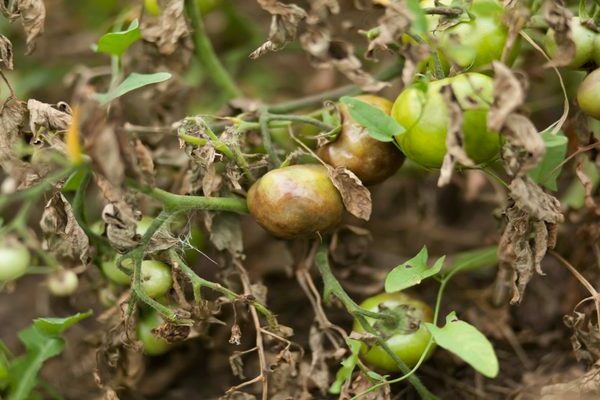
Bordeaux tomato mix
Bordeaux tomato mixture can be used to fight many diseases. For example, late blight, streak or brown spot are perfectly treated with this remedy. All these diseases belong to the Fungal group, therefore, infecting the bush, they begin to spread, first affecting the foliage, moving on to the shoots and the root system.
In the absence of timely treatment, the plant will not be able to develop and will die. How to determine what is affected by the plant? For this, there are many signs for each disease.
- For example, late blight manifests itself as small weeping spots on tomato leaves. These spots are getting darker every day, reaching brown. Also, a small layer of plaque appears on the leaves, which has a white-gray color. When the stage is advanced, the leaves begin to dry and crumble. Tomatoes with late blight are not red, but burgundy, and they are prohibited for consumption. With late blight, Bordeaux liquid will come to the rescue. All affected parts must be removed and burned, and the remaining surface must be carefully treated.
- Strikom tomatoes are infested quite rarely. This disease is very dangerous as it infects the plant with amazing speed. The lesion begins immediately from the center of the plant and the tomato can be completely covered in a few days. When infected with a streak, treatment should be carried out immediately, without hesitation. Signs will help to recognize infection with this particular disease. Due to the streak, the fruits are covered with orange-red spots. You may also notice the poor condition of the plant. It is sluggish and slowly developing. There may also be yellow specks on the fruits, and the fruits will begin to rot.
- Brown spot is common among tomato diseases. It arises from insufficient care, like many diseases. It can be recognized by the light spots on the top of the plant. These spots become larger and darker every day, up to a reddish-brown color. It is called brown because large spots of this color appear in the lower parts of the tomato.
Note: Before carrying out the treatment with Bordeaux liquid, it is necessary to clean indoor or outdoor ground from contaminated parts. All of these parts must be burned so that the disease does not spread to other crops.
Bordeaux liquid is used foliarly using a spray bottle. It is worth very careful when preparing the solution so as not to harm yourself and the plant.
Bordeaux mixture does its job well, and is also an excellent prophylactic agent so that fungal diseases do not infect tomato bushes.
Bordeaux mixture: application for tomatoes. Correct calculation of ingredients
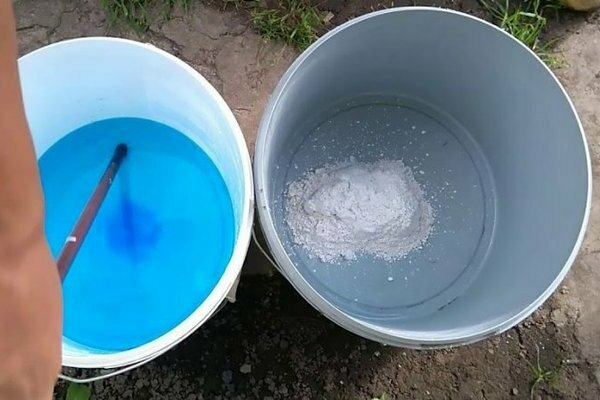
Bordeaux tomato mix
The correct ratio is very important in preparing this solution. The concentration of the liquid should be 1% or less. The steps are the same for each preparation of the solution. The only difference is in additional components and solution concentration.
- To prepare a 1% solution, you need to take 5 liters of warm water. Add 50 grams of copper sulfate, as well as 70 grams of calcium oxide.
- To prepare a solution of a lower concentration, you will need 5 liters of water, copper sulfate in an amount of 30 grams and quicklime (another name for calcium oxide) in an amount of 50 grams.
Note: The volume of the solution depends only on the number of tomato bushes, 1 liter of solution is used for 4-5 square meters.
Where to buy the ingredients for the solution
All components can be purchased at a specialty garden store. They are sold in bags that differ in filling, in the amount of product.
Experienced vegetable growers recommend buying a large enough amount of the product, as you may not have enough. And the wrong concentration of the solution can be detrimental to tomatoes. They adhere to the rule that it is better to leave than not enough.
Calcium oxide, or otherwise it is called quicklime, has a crystal structure. It appears after the process of calcining the limestone rock has been carried out. This remedy is not the safest, so it should be used carefully.
Note: It is very important that calcium oxide should only be stored in a dry and dark place.
Crystals of a deep blue color are called copper sulfate. It is quite insecure, therefore it requires some security measures. It should only be borne in mind that it must be not expired and must be stored in a dry place where it is cool. For example, a basement is perfect, only in the most unlit place, where there is no water.
Bordeaux mix for tomatoes. Instructions for preparing the solution
To prepare the solution, you will need some items. I need to buy gauze. It is useful for filtering. And also a sieve, containers of different sizes (5 liters and 10 liters), nails. A wooden stick is also useful to stir the solution.
Note: The containers should never be made of metal. An iron or aluminum bucket will not work. But a plastic, glass or wooden container is perfect.
Cooking instructions.
To properly dilute this substance, you must follow certain instructions:
- To begin with, 2 liters of warm water are poured into a container of 5 liters.
- Then vitriol is added to it in the required amount and stirred until the last crystal.
- After that, cold water is added in an amount of 3 liters and the solution is well mixed.
- Then a second container is taken and 2 liters of water are added to it, after which the addition of calcium oxide begins.
- To extinguish calcium oxide, the solution must be thoroughly mixed. Water, interacting with calcium oxide, turns into a solution that is very similar to milk.
- Then 3 liters of water are poured into the second container.
- The first container must be poured into water with lime and mixed well.
- The solution should be of a uniform turquoise color, without lumps.
- To make the mixture as homogeneous as possible, it must be filtered using gauze. It should be folded in 3-4 layers for the best result. Or a sieve is used.
- After straining, the solution can be used for processing tomatoes.
Any recipe is prepared only according to these instructions, only the number of components changes in it. Otherwise, the mixture will turn out to be wrong and stop working, or harm the plant.
What should not be done when preparing a solution?
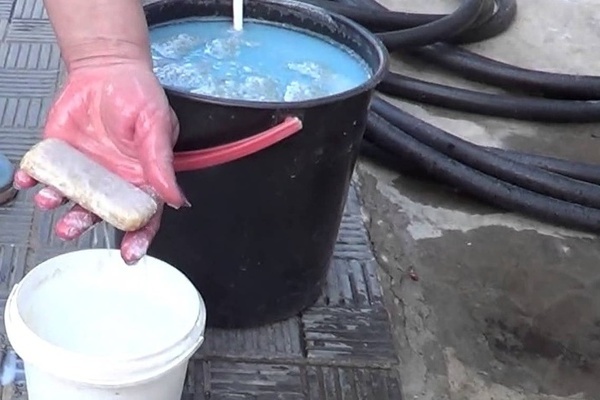
- Change the sequence of adding components.For example, if you add lime liquid to a solution of copper sulfate, you will end up with an ineffective mixture that will not help get rid of diseases.
- In no case should you mix dry components and only then add water. In this case, the components will not work.
- When mixing the last two solutions, their temperature should be approximately the same.
Bordeaux mix for tomatoes. How to check the quality of the solution?
Quality control is carried out according to certain criteria. If all ratios were performed correctly, and the mixing scheme did not change, then the mixture should be like a suspension in consistency. Also have a bright blue color and reaction if alkaline liquid is added.
With an increased acidity of the solution, it cannot be used, as damage to the tissues of the tomatoes will occur. If, nevertheless, treatment with such a solution is carried out, then yellow stripes will begin to appear on the fruits, along which the tomatoes will crack.
At high alkalinity, the solution is not dangerous, but it will not adhere to the surface of the plant, and will show an ineffective effect.
When the solution is completely stirred, a small sediment may settle at the bottom, this is not dangerous. This can happen with the wrong ratios. Most often with an excess amount of calcium oxide. This precipitate may be present. It does not affect performance in any way, so it can be used.
How to check the alkalinity and acidity of a solution?
There are two methods for checking these criteria.
- For the first method, you need to buy a litmus test. It changes color and indicates the environment of the solution.
- For the second method, you need phenolphthalein paper. With increased acidity, the piece of paper becomes crimson.
Note: If you do not have either litmus or phenolphthalein paper, you can use a regular nail. It must be dipped in a solution. If a small layer of plaque appears on it, which resembles copper in color, this means that all proportions have been calculated correctly, and the solution can be used to process tomatoes. But, in order to use it with peace of mind, it is best to add a little more lime mortar. An excess of this solution will not harm, but on the contrary, its lack will harm.
What are the processing times?
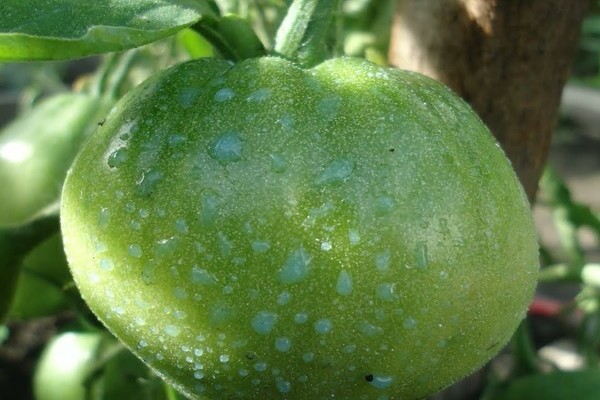
Processing must meet three criteria.
Firstly, spraying should not be performed if other crops grow near the tomatoes during fruiting, since Bordeaux liquid will affect the fruits.
Secondly, during the fruiting period, 15 days before harvest, processing with such a solution is strictly prohibited.
Thirdly, during the period of flower and fruit formation, processing is not carried out.
Note: The weather should be calm, sunless and dry.
How to apply the solution?
The prepared solution should be sprayed on the surface of the tomatoes. For spraying, a spray gun with a small tip is used.
Liquid treatment is carried out only on the infected surface of the plant. Healthy leaves and shoots should not be affected. The surface should be evenly coated with liquid.
The vegetable grower who carries out the treatment must protect himself from liquid getting on the skin. Gloves and long sleeves can be worn. This safety measure is necessary, since if it comes into contact with the skin, it burns a little and the area needs to be treated with running water.
How many treatments need to be done?
- For the whole season of tomato development, 4 treatments must be done. In no case should there be more of them.
- Tomatoes are recommended to be processed with a low percentage of Bordeaux liquid, less than one percent. Such a solution is considered more gentle and, if applied excessively, does not greatly injure the plant.
- 7-12 days should elapse between each treatment.
- If you notice a fungal disease while growing seedlings, it is necessary to carry out the treatment 2 weeks before transplanting into open or closed ground.
Processing tomatoes with Bordeaux mixture. Pros and cons
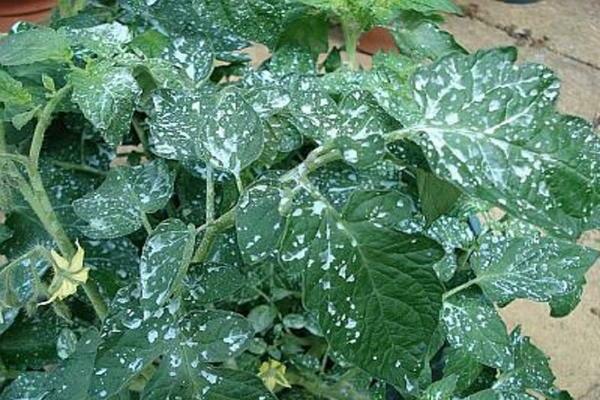
Positive sides:
- Bordeaux liquid is very effective and does its job perfectly.
- This solution can fight many diseases.
- The action after processing lasts for a whole month.
- After application, you can immediately determine if the solution is working or not. If the plant begins to have a blue tint, this means that the solution is working.
- On rainy days, the solution still remains on the surface of the plant.
- The solution consists of all available components.
- Insects do not suffer from the processing of Bordeaux fluid, since it does not affect them in any way.
Negative sides:
- Difficulty in preparing a solution. You must strictly follow the instructions.
- After processing, the stems can be damaged and can also break under the force of the tomatoes. This can be avoided by tying to a support.
- If you spray the plant with an excessive amount of solution, small cracks may begin to appear on the fruits and the growth of the plant may slow down.
Note: Although Bordeaux liquid has disadvantages, there are many more advantages.
Precautionary measures

In order for the Bordeaux liquid solution not to cause any harm to the vegetable grower, who will carry out the processing, certain safety measures must be followed.
- When processing, it is in gloves and in clothes that will cover the body. It is also recommended to wear safety goggles and a bandage that will protect the airway.
- Do not eat or drink during processing. Otherwise, the solution may get inside.
- Fifteen days before harvesting, the fruits should not be touched or processed by anything.
- After treatment, hands, face and body should be well washed.
- During processing, there should be no animals, children or unprotected adults near the grower.
Note: If used improperly, copper sulfate can be poisoned. The mucous membranes of the eyes and nose will be irritated, you will sneeze and feel weak. For all symptoms, see a doctor. If you have not inhaled copper sulfate, then you can use a regular diuretic and antipyretic drug and the substance will quickly leave the body. Drinking plenty of fluids is also recommended.
If the solution gets on the skin, rinse the skin with running water and take absorbents. It is necessary to cleanse the body with activated carbon, it will absorb all the bad substances and will not allow them to be absorbed.
Conclusion
This tool perfectly relieves tomatoes from various fungal diseases, but when using it, you must follow certain safety measures so as not to harm your body.
It is worth noting that the solution must be prepared strictly according to the instructions. Otherwise, it will either become ineffective, or it will greatly harm the tomato.

